How to Grow Holy Basil Plant
- March 25, 2024
- 0 comment
How to Grow Holy Basil Plant delves into the cultivation of this revered herb, known as Tulsi in Hindi, which holds a special place in Hinduism and Ayurvedic medicine. Beyond its religious and medicinal significance, Holy Basil is a cherished addition to home gardens. This guide makes the process straightforward, offering clear guidelines to help you nurture and grow a healthy Holy Basil plant. By adhering to these steps, you’ll be well on your way to adding this sacred herb to your garden, enjoying both its spiritual and health benefits.
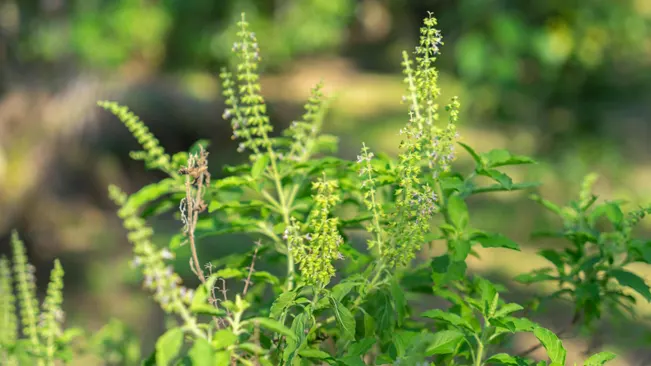
Holy Basil Benefits
| Benefit | Description |
|---|---|
| Reduces Stress & Anxiety | Holy Basil is known for its adaptogenic properties, helping the body cope with stress and promoting mental balance. |
| Boosts Immunity | The plant has immunomodulatory effects, enhancing the body’s defense mechanisms against infections and diseases. |
| Anti-inflammatory Effects | Compounds in Holy Basil help reduce inflammation in the body, beneficial for managing conditions like arthritis. |
| Lowers Blood Sugar Levels | Regular consumption can help in lowering blood sugar levels, beneficial for diabetics or those at risk of diabetes. |
| Supports Heart Health | It aids in lowering blood pressure and cholesterol levels, contributing to overall cardiovascular health. |
| Improves Digestion | Holy Basil can promote healthy digestion and help to settle an upset stomach. |
| Supports Liver Health | It has hepatoprotective properties, supporting liver function and health. |
| Has Antioxidant Properties | The antioxidants present in Holy Basil protect the body from free radical damage, contributing to overall health. |
| Relieves Headaches | Due to its analgesic and soothing properties, it can help alleviate headaches. |
| Dental Care and Oral Health | The antibacterial properties of Holy Basil make it beneficial for dental health, potentially reducing plaque, bad breath, and cavities. |
| Respiratory Benefits | It’s often used to treat respiratory ailments like bronchitis, asthma, and colds due to its antimicrobial and anti-inflammatory qualities. |
List on How To Grow Holy Basil Plant
- Choosing the Right Variety
- Sowing the Seeds
- Ideal Growing Conditions
- Watering and Fertilization
- Pruning and Harvesting
- Pest and Disease Management
- Utilization and Storage
Choosing the Right Variety
There are several varieties of Holy Basil, each with unique properties and flavors. The most common types are Rama Tulsi, Krishna Tulsi, and Vana Tulsi. Rama Tulsi has a milder flavor and is easier to grow for beginners. Krishna Tulsi has a stronger aroma and is known for its medicinal properties. Vana Tulsi is less common but is revered for its spiritual significance.
Rama Tulsi (Ocimum sanctum)
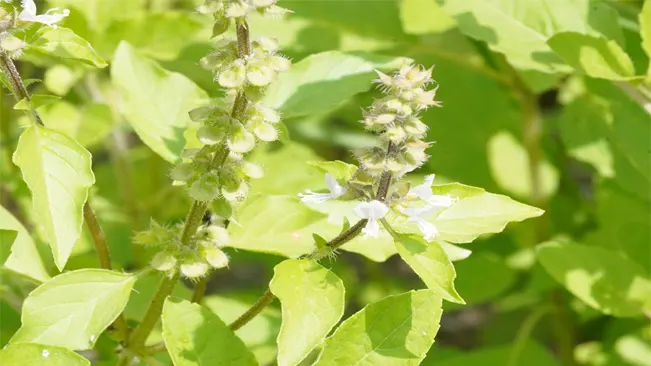
- Characteristics: Rama Tulsi, also known as Green Leaf Tulsi, has light green leaves and a clove-like scent. It grows to a height of about 60 cm and has a bushier plant structure compared to other varieties.
- Flavor: The leaves have a milder flavor, which is less intense than other varieties. It’s often preferred for culinary uses, especially in teas and fresh dishes.
- Growth: This variety is considered the easiest to cultivate, making it an excellent choice for beginners. It is more resilient to colder temperatures and less demanding in terms of care.
Krishna Tulsi (Ocimum tenuiflorum)
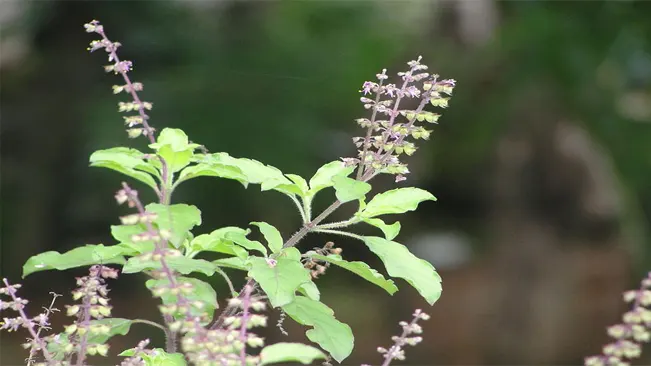
- Characteristics: Krishna Tulsi, known as Purple Leaf Tulsi, is characterized by its dark purple leaves and stems. It’s typically shorter than Rama Tulsi, with a more compact growth habit.
- Flavor: The leaves have a peppery, crisp taste. The stronger aroma and flavor profile of Krishna Tulsi make it highly valued for its medicinal properties.
- Medicinal Use: Often used in Ayurvedic remedies, Krishna Tulsi is believed to have stronger therapeutic properties than other varieties, particularly in terms of respiratory ailments, stress reduction, and boosting immunity.
Vana Tulsi (Ocimum gratissimum)
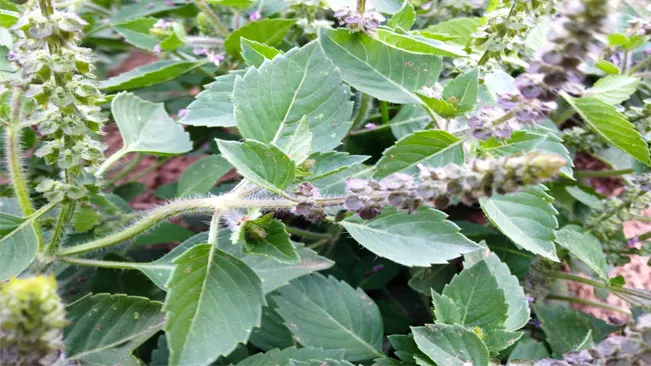
- Characteristics: Vana Tulsi, also known as Wild or Forest Tulsi, is native to India and East Africa. It has green leaves that are larger than those of Rama or Krishna Tulsi and grows taller and more robustly.
- Flavor: It has a lemony aroma and flavor, distinct from the more clove-like taste of Rama and Krishna Tulsi.
- Spiritual and Medicinal Significance: Vana Tulsi is less common in cultivation but is highly revered for its spiritual significance in Hinduism. Medicinally, it shares many of the benefits of the other varieties but is particularly noted for its antiseptic properties.
General Tips for Growing Holy Basil Varieties
- Soil: All varieties prefer well-draining soil rich in organic matter.
- Watering: Regular watering is crucial, but avoid waterlogging. Let the soil dry slightly between watering.
- Sunlight: While they can tolerate partial shade, all varieties flourish best in full sun.
- Pruning: Regular pruning and pinching off flower buds can help maintain a bushy growth and prolong the life of the plant.
Sowing the Seeds
Holy Basil seeds should be sown in the spring when the temperatures start to warm up. The seeds are small, so they should be lightly covered with soil.
Seed Selection
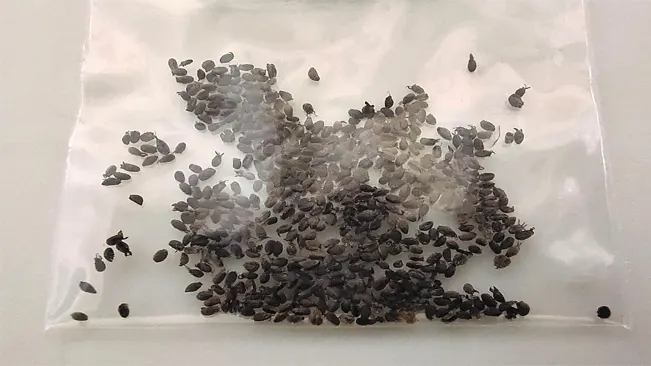
- Quality: Ensure you have high-quality seeds, preferably organic, as they are more likely to germinate and produce healthier plants.
- Variety: Choose a variety of Holy Basil that suits your climate and intended use. Rama, Krishna, and Vana are popular choices.
Preparing for Sowing
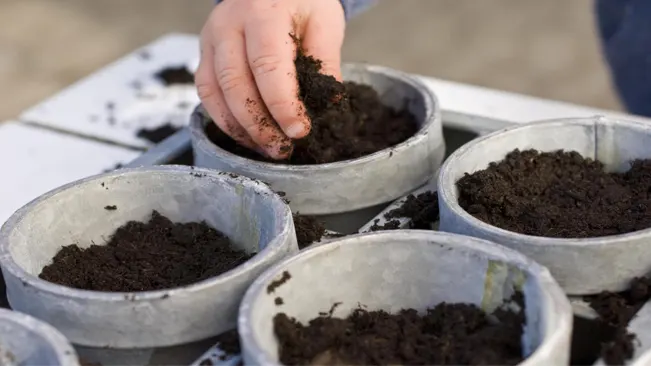
- Season: Sow in spring, but the exact timing can depend on your local climate. In cooler regions, start the seeds indoors and then transplant them outside once the danger of frost has passed.
- Soil Preparation: Use a light, well-draining soil mix. You can create a suitable mix using equal parts of potting soil, compost, and perlite or sand.
Sowing the Seeds
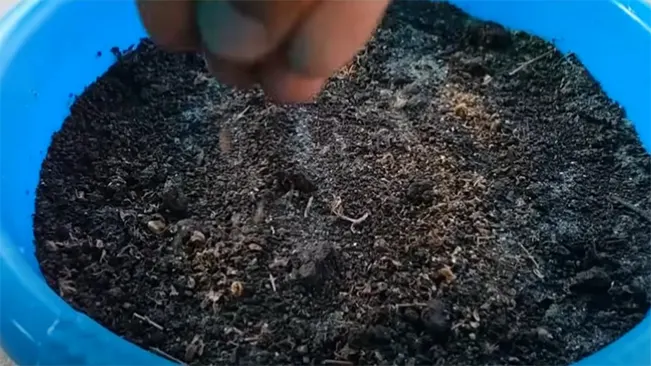
- Planting Depth: Since Holy Basil seeds are tiny, they should be sown just below the surface of the soil—about 1/4 inch deep.
- Spacing: Sow seeds sparingly or thin them out later, as overcrowding can inhibit growth. If starting in a tray, space the seeds about an inch apart.
- Moisture: Keep the soil consistently moist but not waterlogged. Using a spray bottle to mist the soil can prevent the seeds from being disturbed.
- Warmth: Holy Basil seeds need warmth to germinate. Keep the soil at a steady temperature of around 70°F (21°C). Using a heat mat can help in cooler environments.
Germination
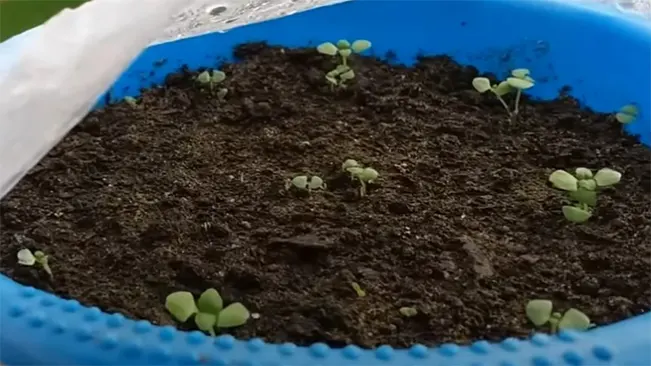
- Timeframe: Most Holy Basil seeds germinate within 1 to 2 weeks. However, some seeds might take a bit longer, so don’t lose hope too soon.
- Light: Once sprouted, seedlings need plenty of light. If growing indoors, place them in a sunny window or use grow lights to ensure they get enough light.
Ideal Growing Conditions
Sunlight
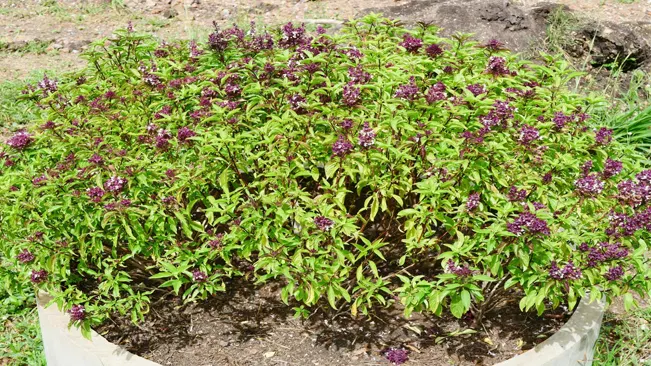
- Full Sunlight: Holy Basil performs best when it receives full sunlight. This means at least 6-8 hours of direct sunlight per day. The sunlight helps the plant to produce the essential oils that give it its characteristic aroma and flavor.
- Partial Shade: Although it prefers full sunlight, Holy Basil can also adapt to partial shade, especially in regions with very hot climates. In such cases, it benefits from some respite from the intense midday sun.
Temperature
- Optimal Range: Holy Basil thrives in warm temperatures, ideally between 70°F and 90°F (21°C to 32°C). This temperature range is conducive to healthy growth and oil production in the leaves.
- Heat Tolerance: It is relatively tolerant of high temperatures, but prolonged heat spells without adequate water can stress the plant.
- Frost Sensitivity: Holy Basil is sensitive to cold and frost. If you live in an area with cold winters, it’s best to grow Holy Basil as an annual or bring it indoors if potted.
Humidity and Air Circulation
- Humidity: In very humid conditions, Holy Basil may be more susceptible to fungal infections. It’s important to ensure good air circulation around the plant to reduce humidity and prevent fungal growth.
- Air Circulation: Adequate space between plants and proper ventilation (when grown indoors) are crucial. This not only helps manage humidity but also reduces the risk of pest infestations.
Light and Shade Management
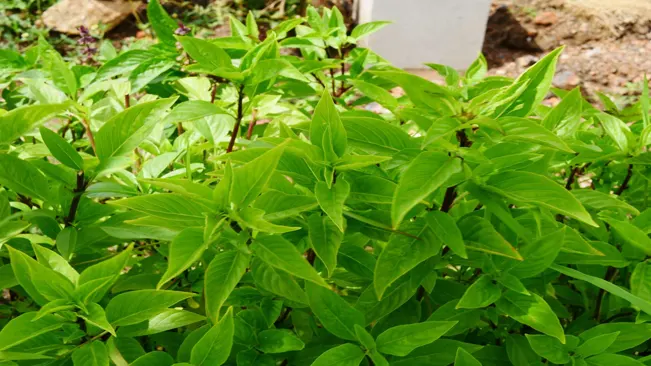
- In Hotter Climates: In areas with extremely hot conditions, some afternoon shade can be beneficial to prevent the plant from getting scorched.
- Indoor Growing: When growing indoors, a south-facing window is ideal. If natural light is limited, supplementing with grow lights can help maintain healthy growth.
Seasonal Considerations
- Spring and Summer: These are the growing seasons for Holy Basil. The plant enjoys the warmth and longer days.
- Autumn and Winter: As the days shorten and temperatures drop, growth will slow down. In colder regions, it’s time to harvest and prepare the plant for the end of its growing cycle.
Watering and Fertilization
Watering Holy Basil
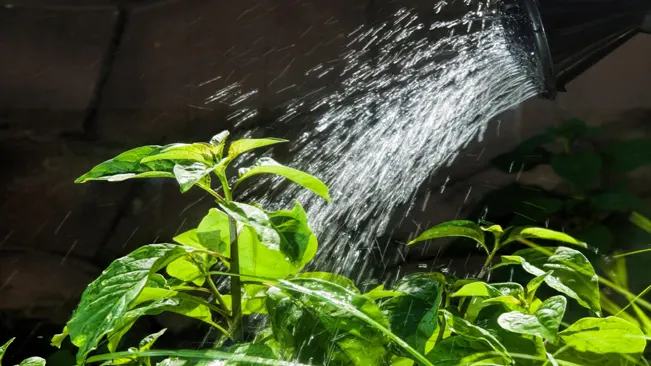
- Frequency of Watering: Holy Basil needs consistent moisture, but it’s important not to overwater it. The frequency of watering will depend on the climate and soil type. In general, water the plant when the top inch of the soil feels dry to the touch.
- Method of Watering: Use a watering can or a hose with a gentle spray setting to avoid disturbing the soil. Water at the base of the plant rather than overhead to reduce the risk of fungal diseases.
- Monitoring Soil Moisture: It’s beneficial to regularly check the soil moisture. In hotter weather, the plant may need more frequent watering. Conversely, in cooler or overcast conditions, it may need less.
- Drainage: Ensure that the pot or the garden bed where the Holy Basil is planted has good drainage. Poor drainage can cause water to accumulate around the roots, leading to root rot.
Fertilizing Holy Basil
- Type of Fertilizer: A balanced, organic fertilizer is recommended for Holy Basil. Organic fertilizers release nutrients slowly, which is beneficial for the steady growth of the plant.
- Frequency of Application: Fertilize the plant every 4-6 weeks during the growing season. The frequency can be adjusted based on the plant’s response. If the plant appears lush and healthy, reduce the frequency.
- Avoiding Over-fertilization: Over-fertilization can harm the plant, leading to excessive foliage growth at the expense of flavor and medicinal properties. If you notice signs of over-fertilization, such as yellowing leaves or a decrease in flavor, stop fertilizing for a while.
- Compost and Mulch: Adding compost can enrich the soil naturally. Mulching around the base of the plant helps retain soil moisture and suppresses weeds, reducing the need for frequent watering.
Pruning and Harvesting
Pruning for Healthier Growth
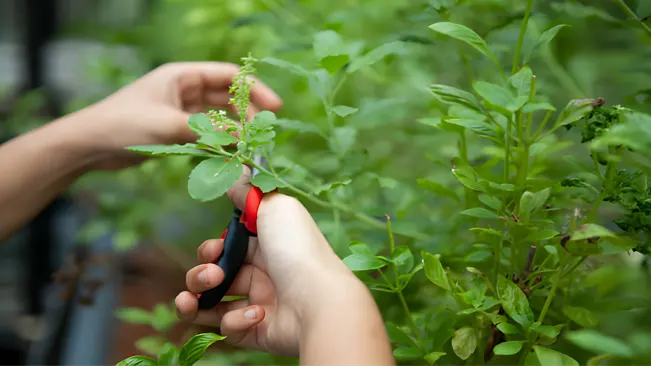
- Encouraging Bushiness: By pruning, you encourage the plant to grow laterally rather than just vertically. This results in a fuller, bushier plant rather than a tall, leggy one.
- When to Start Pruning: Begin pruning when your Holy Basil reaches about 6 inches in height. This is usually a few weeks after germination, depending on growing conditions.
- How to Prune: Use your fingers or clean scissors to pinch off the top center shoot of the plant, just above a set of leaves. This will stimulate the plant to produce two new shoots from the leaf nodes below the cut.
- Regular Maintenance: Continue to prune regularly, especially the top shoots. This process keeps the plant from flowering too early. Flowering can divert energy away from leaf production, which is usually the desired harvest from Holy Basil.
Harvesting Techniques
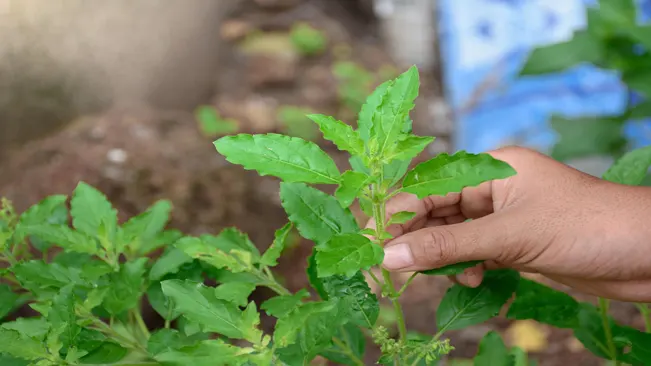
- When to Harvest: You can begin to harvest leaves once the plant has become bushy and has plenty of leaves. This typically happens a few weeks after the initial pruning.
- How to Harvest: Gently pluck individual leaves or cut whole stems if needed. It’s important to cut stems above a leaf node, as this will encourage new growth.
- Sustainable Harvesting: Always leave enough leaves on each stem to ensure the plant remains healthy and continues to grow. A good rule of thumb is to leave at least one-third of the leaves on the plant.
- Optimal Harvest Time: Early morning is considered the best time for harvesting herbs, including Holy Basil. This is when the plant’s oils are most concentrated, providing the best flavor and medicinal properties.
- Using Fresh vs. Drying: Fresh leaves can be used immediately in teas or cooking. If you wish to dry them, hang bunches of stems in a warm, dry place away from direct sunlight. Once dry, the leaves can be stored in airtight containers.
Pest and Disease Management
Pest Management
- Common Pests:
- Aphids: These small, soft-bodied insects can cause leaf distortion and reduced plant vigor. They often appear on the undersides of leaves.
- Spider Mites: These tiny pests can cause yellowing or speckling on leaves and, in severe cases, lead to leaf drop.
- Whiteflies: These are small, white-winged insects that feed on plant sap and can weaken the plant.
- Control Measures:
- Regular Inspection: Frequently check your plants for signs of pests, especially under leaves.
- Natural Predators: Encourage beneficial insects like ladybugs and lacewings, which feed on aphids and mites.
- Neem Oil: This is a natural pesticide that’s effective against a variety of pests and is safe for the plant.
- Insecticidal Soap: Use this for controlling infestations; it’s particularly effective against soft-bodied insects like aphids.
Disease Management
- Common Diseases:
- Fungal Diseases: Holy Basil can be susceptible to various fungal infections, especially in humid conditions. This includes diseases like powdery mildew and root rot.
- Prevention and Control:
- Air Circulation: Ensure good air flow around your plants. This can be achieved by not overcrowding your plants and by proper pruning.
- Watering Practices: Water at the base of the plant to avoid wetting the foliage, which can encourage fungal growth.
- Proper Spacing: Plant Holy Basil with enough space between each plant to reduce humidity levels around the foliage.
- Organic Fungicides: In case of a fungal outbreak, use organic fungicides like sulfur or copper-based sprays, following label instructions carefully.
- Other Considerations:
- Crop Rotation: If you are growing Holy Basil in the same area year after year, consider rotating with other crops to prevent disease buildup in the soil.
- Sanitation: Remove and destroy any infected plant parts immediately, and avoid composting them to prevent the spread of disease.
Utilization and Storage
Holy Basil leaves are commonly used fresh in teas and for culinary purposes. They can also be dried for later use. To dry, tie the harvested stems in small bunches and hang them upside down in a warm, dry, and well-ventilated area. Once dried, the leaves can be stored in an airtight container.
Utilization of Holy Basil Leaves
- Tea Preparation: One of the most popular uses of Holy Basil (Tulsi) is in brewing herbal tea. Fresh or dried leaves can be steeped in hot water to make a soothing and aromatic tea, often enjoyed for its stress-relieving properties.
- Culinary Uses: Fresh Holy Basil leaves can be used in a variety of dishes. They add a peppery flavor to salads, pastas, and sauces. In Indian cuisine, they’re a key ingredient in many traditional recipes, including stir-fries and soups.
- Medicinal Uses: Holy Basil is valued in Ayurveda for its therapeutic properties. It’s used in remedies for colds, flu, and as a general immune booster. The leaves are also used in homemade skincare remedies, owing to their anti-inflammatory and antibacterial properties.
- Aromatherapy: The aromatic oils in Holy Basil are sometimes used in aromatherapy for relaxation and to alleviate symptoms of stress and anxiety.
Storage of Holy Basil Leaves
Drying Process
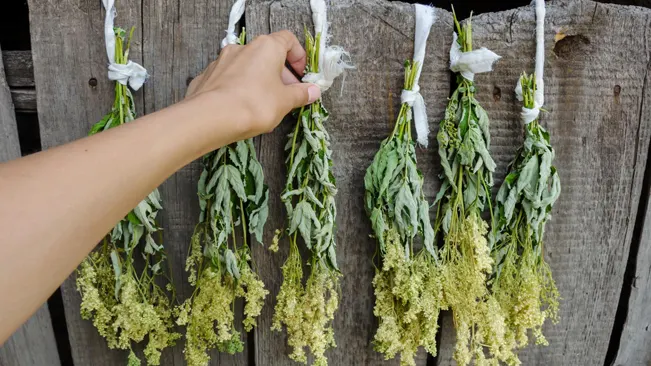
- Method: After harvesting, the leaves can be tied in small bundles and hung upside down in a warm, dry, and well-ventilated area. This protects them from direct sunlight which can cause loss of flavor and medicinal properties.
- Timeframe: The drying process typically takes about a week, depending on the humidity and temperature of the area.
Storage
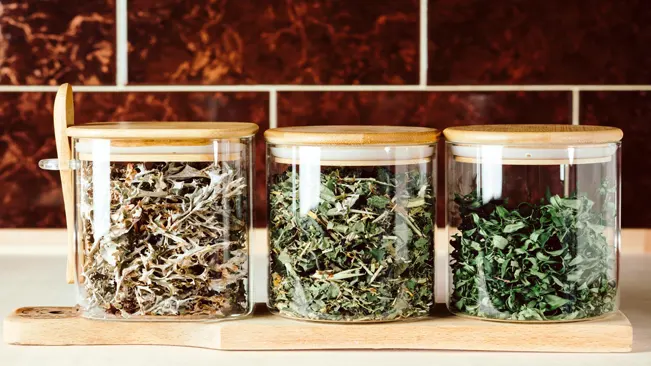
- Container: Once fully dried, the leaves should be crumbled and stored in an airtight container. This helps to preserve their aroma and medicinal qualities.
- Location: Store the container in a cool, dark place to prevent degradation of the leaves’ essential oils and compounds.
Shelf Life
- Dried Holy Basil leaves can last for up to a year if stored properly. However, for best flavor and efficacy, it’s recommended to use them within six months.
Freezing
- As an alternative to drying, Holy Basil leaves can also be frozen. Freezing retains more of the plant’s flavor and is a good option if you plan to use the leaves for cooking. Fresh leaves can be washed, dried, and stored in freezer-safe bags.
Preservation in Oil
- Another method is to preserve the leaves in oil. This method involves submerging fresh Holy Basil leaves in olive oil, which can then be used for cooking or as a dressing.
Conclusion
Growing Holy Basil is not only a spiritually fulfilling activity but also a step towards embracing a healthier lifestyle. With its easy-to-follow growth and care requirements, it’s a perfect addition to any home garden. By nurturing this sacred plant, you can enjoy its aromatic leaves, medicinal benefits, and its serene presence in your home.
FAQs (Frequently Asked Questions)
- What is the best time to plant Holy Basil?
Holy Basil should be planted in the spring when the danger of frost has passed and temperatures are consistently warm. - Can I grow Holy Basil indoors?
Yes, Holy Basil can be grown indoors. It requires a sunny spot (like a south-facing window) and regular watering. - How much sunlight does Holy Basil need?
Holy Basil thrives in full sunlight but can tolerate partial shade. Ideally, it should receive at least 6 hours of sunlight daily. - How often should I water Holy Basil?
Water the plant when the top inch of the soil feels dry. It’s important to keep the soil moist but not waterlogged. - Does Holy Basil need special soil?
Holy Basil prefers well-draining, fertile soil. A mix of potting soil with compost works well for providing nutrients. - When and how should I harvest Holy Basil?
Start harvesting when the plant is about 6 inches tall. Pinch off the leaves or tops of the stems to encourage bushier growth. - How do I protect Holy Basil from pests?
Regularly check for pests like aphids and spider mites. Use organic pesticides like neem oil for treatment if necessary. - Can Holy Basil survive in winter?
In colder climates, Holy Basil is treated as an annual. It can be grown indoors during winter but may not survive outdoor frost. - Should I fertilize my Holy Basil plant?
Fertilize every few weeks with a balanced, organic fertilizer, but avoid over-fertilization to maintain the plant’s flavor and medicinal quality. - How do I prune Holy Basil for better growth?
Pinch off the top center shoot to prevent early flowering and to encourage the plant to become bushier.
For more expert gardening and advice, explore our guides, discover top recommendations in our best section, and delve into in-depth product reviews in our review section. Happy Gardening.

Kristine Moore
Forestry AuthorI'm Kristine Moore, a seasoned garden landscaping professional with over 30 years of experience. My extensive career has been dedicated to transforming outdoor spaces into stunning, sustainable landscapes. With a deep understanding of horticulture, design principles, and environmental stewardship, I have become a respected figure in the field, known for creating harmonious, visually appealing, and eco-friendly gardens. My commitment to excellence and continuous learning in landscaping trends and techniques has solidified my reputation as an expert in garden design and implementation.





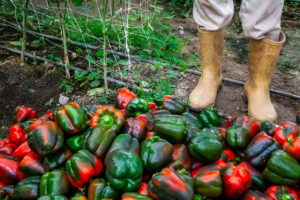







Leave your comment